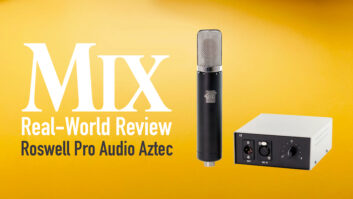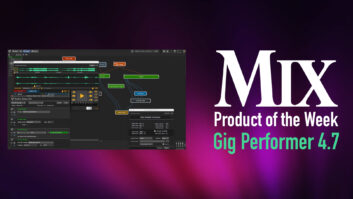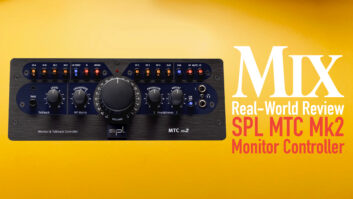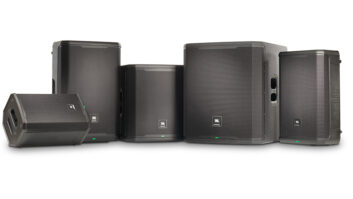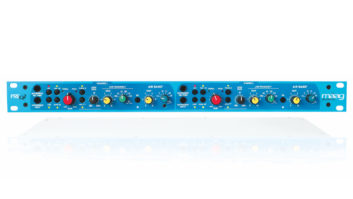Let’s face it, power amps are the Rodney Dangerfield of pro audio equipment. They’re not particularly interesting to look at, they all sound great (or we get rid of ’em!), and they usually get placed away from all the other equipment. Do they get any respect? Not until they fail-at which point, they command all the attention. Isn’t it interesting how these black (okay, sometimes they come in different colors) boxes can bring the entire show/studio to its knees when they decide not to cooperate? Of course not! The point is, we depend on these vital components far more than we care to admit.
Now that we are thinking about power amps, how are they progressing from a technological perspective? What are we likely to see in future product designs? Considering their level of importance to virtually every studio, contractor installation, touring act and theater, it makes sense to consider what changes may be headed our way. During the course of my interviews with the key manufacturers in this area, several important trends in power amp design emerged. Whether you’re searching for an amp that is lighter, more efficient, or has a greater level of interactivity with other components in your production environment, there are some interesting developments worth examining.
ACTIVE DEVELOPMENTS IN POWER AMPSWhere is amplifier technology headed? Active loudspeakers are certainly a good place to begin. While the term “powered monitors” used to be a dirty word, much has changed recently and all indicators point toward numerous such products in the future.
Bill Calma, chief operating officer at Tannoy/TGI North America Inc., offered this perspective: “The biggest trend will be active loudspeakers, due to the reduced size and weight of switching power supplies and the latest amplification circuitry. While powered loudspeakers have been around for some time, the industry is on the verge of a proliferation of products. This is the result of significant advances in electroacoustics and DSP processing.”
There’s good reason for this development. This design approach is intended to give the end-user greater control of the overall system. Since many power amps have already reached the point where they deliver more power than the speakers can handle, the focus needs to shift toward more efficient systems design-that system, of course, being the combination of power amp and speakers.
David Solari, president of CyberLogic, concurs. “More and more, we see power amplifiers being integrated into loudspeakers-either as in-cabinet designs or dedicated ground support systems whereby the amp is specifically tailored to a specific speaker cabinet. Rather than trying to build amps that ‘do all things for all people,’ this trend will result in power amps being built and configured specifically for a particular task-resulting in improved cost efficiency for the manufacturer and better value for the customer.”
Switching power supplies are also a hot topic with manufacturers these days. Since nobody wants to drag heavy equipment around, a power amp’s weight is a major consideration for touring acts. Switching power supplies both reduce the amplifier’s weight and increase its efficiency.
Although they involve greater expense and more parts, switching power supplies offer distinct advantages. For example, it is easier to regulate the operation of the high-frequency transistors to compensate for variations in the AC voltage and load currents-thus improving power supply regulation. This, in turn, results in more consistent amplifier performance.
Stephen Morris, product line manager at Crown International, considers switching power supplies to be a critical issue for amplifier development. “I believe a large percentage of the focus for manufacturers will be on the power supply portion of the amplifier,” he says. “The market is now asking for lighter-weight amps that can also provide appropriate power under normal operating conditions, but with reduced current draw. One of the quickest ways to achieve this is to provide a switching power supply. This design requires much lighter and smaller magnetics, with the key benefit being significantly reduced weight.”
When a product is rated to meet a particular power specification relative to its impedance, the rating is based on the assumption that the unit will draw a designated amount of current. Now manufacturers are required to provide more efficient designs by reducing the amount of current the amplifier draws-largely because European countries have particularly stringent standards in this area. The issue is known as power factor correction (PFC)-with the crux of the matter revolving around the need to draw less power from the wall to get the same amount of power from the amplifier.
QSC’s PowerLight 9.0PFC, released in 1998, was the first to amp include Power Factor Correction in its power supply. PFC can reduce the amplifier’s average AC current consumption by as much as 40%, and peak requirements by as much as 80%.
REMOTE OPERATIONWhile a select number of currently available products can be remotely controlled, efforts are underway to improve connectivity via the Internet as well as local-area networks (LANs). The ability to monitor the diagnostics of equipment and provide updates will become even more important than they are now.
A major advancement in this area has been the development of CobraNet technology. This combination of firmware and a network protocol licensed by Peak Audio allows the transmission of multichannel digital audio signals across an otherwise standard Ethernet network. However, for the purposes of supplying data signals only in a networked system, standard 10Mbit Ethernet can handle hundreds of amplifier control channels with near-instantaneous response, at a fraction of the bandwidth required for multichannel digital audio. Although CobraNet has the capablility of combining audio and control data on a single physical network, existing control systems do not currently use CobraNet for control and monitoring. Thus far, however, this aspect of CobraNet technology has yet to be realized, though key manufacturers are committed to improving the situation.
Since the early 1990s, QSC has been manufacturing computer control systems for remote-control capability in power amplifiers. “We see a strong future in connectivity options for power amps,” says QSC vice president of engineering, Pat Quilter. “We’ve recognized this trend by incorporating computer control capability into nearly all of the amplifier lines that we have developed in the past five years. In fact, more than half of the amplifier models we build today include a DataPort to interface with computer control systems. We are targeting our future products to be as universally connectable as possible. We want everything we release to be Windows compliant, Internet accessible and to take full advantage of modern concepts such as downloadable code. We currently have remote-controllable products and are a major player in the RAVE-CobraNet arena.”
Jack Sondermeyer, manager of analog engineering at Peavey, stresses: “Digital technologies such as MediaMatrix and CobraNet will continue to play an increasingly important role in Peavey’s product development, and I can certainly envision expanded control options via the Internet in future designs. Our power amplifiers are an integral component of these systems, and we will be focusing our efforts on connectivity issues as well as DSP functionality.”
As power amplifiers enter the digital domain, the element of control becomes a major issue. This development will likely have a significant impact on a product’s features and capabilities, which mainly lie in the integration aspects of a system. “We envision the use of digital electronics in producing ‘intelligent’ loudspeakers that can compensate in a variety of ways for their immediate environment,” says Calma. “The demand on the amplifier, not only as the source of the power, but also as a conduit to feed information from the operator to the speaker and from the speaker to the operator, will be a key aspect of future system development.”
ADVANCING THE STATE OF THE ARTSo what should you buy now? Which products are the most technologically advanced? There’s no single answer to these questions. Touring acts may be concerned primarily with weight and raw power, and a contractor may be focused on networking issues. Meanwhile, recording facilities want purity of sound. It all boils down to the type of production environment you work in. With that said, let’s take a look at what the manufacturers are doing to improve our situation.
Jim Strickland-VP of engineering at Rockford Corporation, which manufactures Hafler equipment-says his company’s TransoNova design has played a major role in the advancement of power amp technology. “TransoNova employs cooperation between voltage feedback, fed through the feedback resistor, and signal current from the driver stage. The result of this technology is an output stage with 100 percent negative [voltage] feedback, with no loss of voltage gain,” he explains. “We’ve also employed a constant power system in our amps that facilitates the tailoring of supply voltage and amperage to the correct value for 2-, 4- and 8-ohm loads and appropriate 70- and 100-volt lines-all at high efficiency. This eliminates the thermal shutdowns that can occur when attempts are made to get rated power into low-Z loads.”
At QSC, the focus is on connectivity issues as well as switching power supplies. “We see a strong future in connectivity options for power amps, and we expect to offer such facilities during the next 18-month cycle,” says Quilter. “That’s not to say that every product we release in the near term will have every feature we envision, but our architecture is designed to support them. Currently, we consider ourselves leaders in high-current MOSFET output technology-as embodied in the 6.0/9.0 PowerLight Series. We are also very committed to advancing lightweight, high-power, switching power supply technology.”
Switching amplifier technology and connectivity issues are also hot topics at Crown. “Crown is leveraging its BCA [balanced current amplifier], Class-I [interleave] topology,” Morris says. “This is a switching amplifier design that is unique on the market and offers improved efficiency over existing designs. The company is also flexing its muscle in the area of communication capabilities via its own proprietary IQ software for Windows. IQ for Windows facilitates communication between the various components on a network as well as to a centralized control station. Further, we are working toward implementing CobraNet as the core to our system solutions. A Crown/CobraNet solution will provide true open architecture, allowing for a robust network to carry both audio and control information to key devices in the signal path.”
Peavey’s Sondermeyer stresses that as digital technology spreads through all segments of the industry, the need for greater connectivity among manufacturers and DSP processing power will become more important. “Our Media- Matrix system has met with widespread acceptance among the contractor market, and as digital networking systems such as CobraNet become more common, DSP technologies will play a vital role in the advancement of these systems,” Sondermeyer explains. “We are currently working with computer-controlled systems for a variety of signal-processing effects from common reverbs through modeling algorithms. We fully intend to exploit this technology with a variety of modules and stand-alone devices that can be incorporated into this area.”
CyberLogic has found its niche in our industry by concentrating its efforts on multichannel amplifier design. The company currently offers 4- and 8-channel configurations and is always seeking new ways to refine its product offerings, says Solari. “We’ve added 3-Phase powering to our multichannel systems,” he notes. “In doing so, we achieve simplified AC wiring along with true load balancing, as each amp is using all three legs of the 3-Phase power structure. Thus, the amps are automatically balanced in terms of current draw across the different legs. Additionally, we don’t use the neutral line for the return of current, meaning that you’re not pulling the neutral line away from ground. All of this translates to the substantial reduction, if not total elimination, of hum problems.”
With its focus on active speakers, Tannoy is integrating a technology known as PRO BASH into is current designs. Calma describes the technology: “PRO BASH is digitally controlled analog amplification. Using a PWM [pulse width modulation] design feeding a Class-AB output stage, we’re able to deliver huge power [1000W] very efficiently. The result is extremely low heat generation and low AC current draw. We believe PRO BASH offers all the performance you would expect from a linear AB amplifier combined with the speed and efficiency of a digital amplifier. We feel this technology will raise the bar in the pro audio industry.”
As the industry addresses the various challenges of amplifier design and system integration that lie ahead, it’s important not to lose sight of how far we’ve come. The old adage “Rome wasn’t built in a day” seems appropriate at this point. Several manufacturers have products available now that address some of these issues, and more solutions are coming our way. Like any technology, the progress is likely to be evolutionary as opposed to revolutionary.
